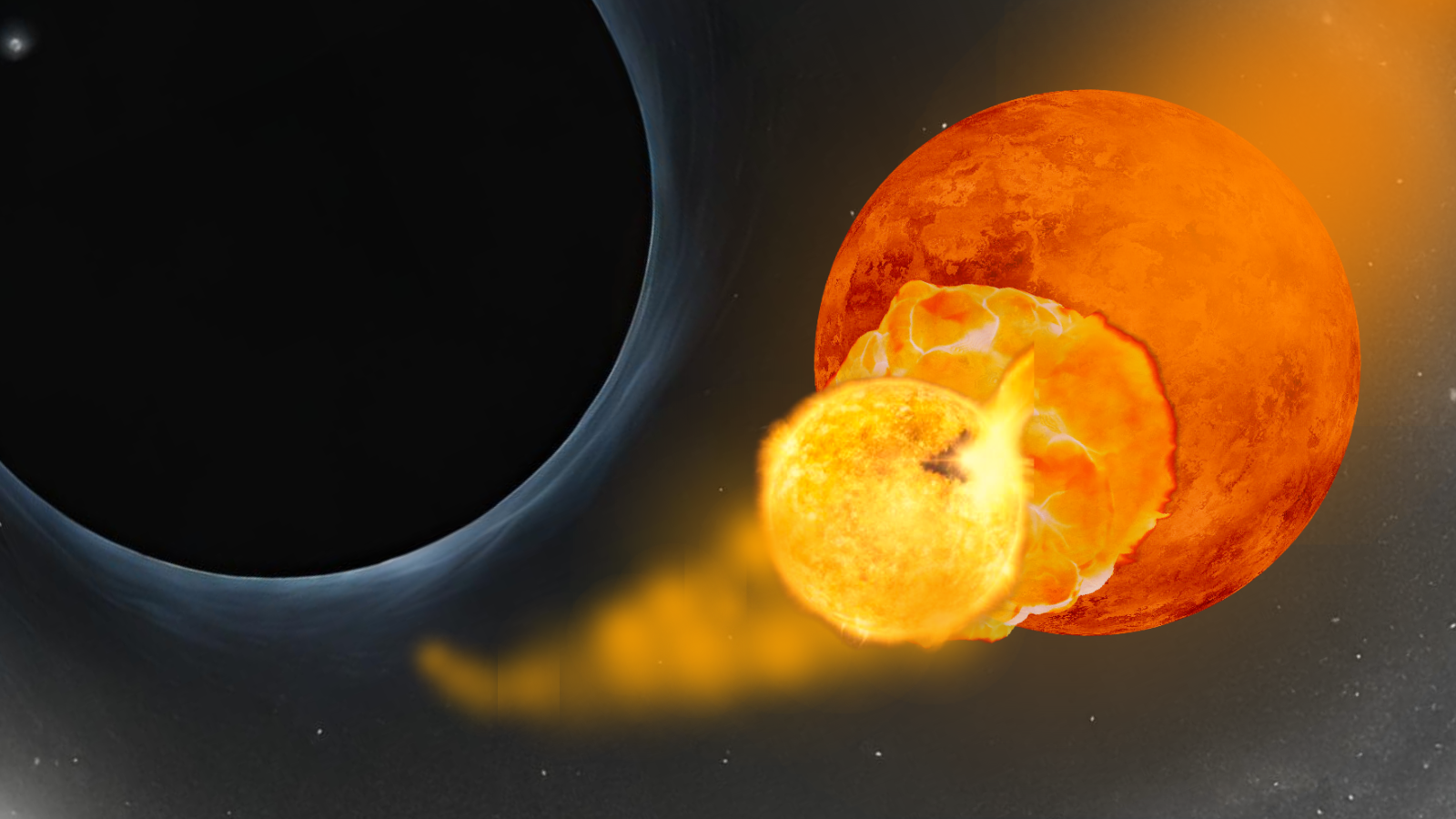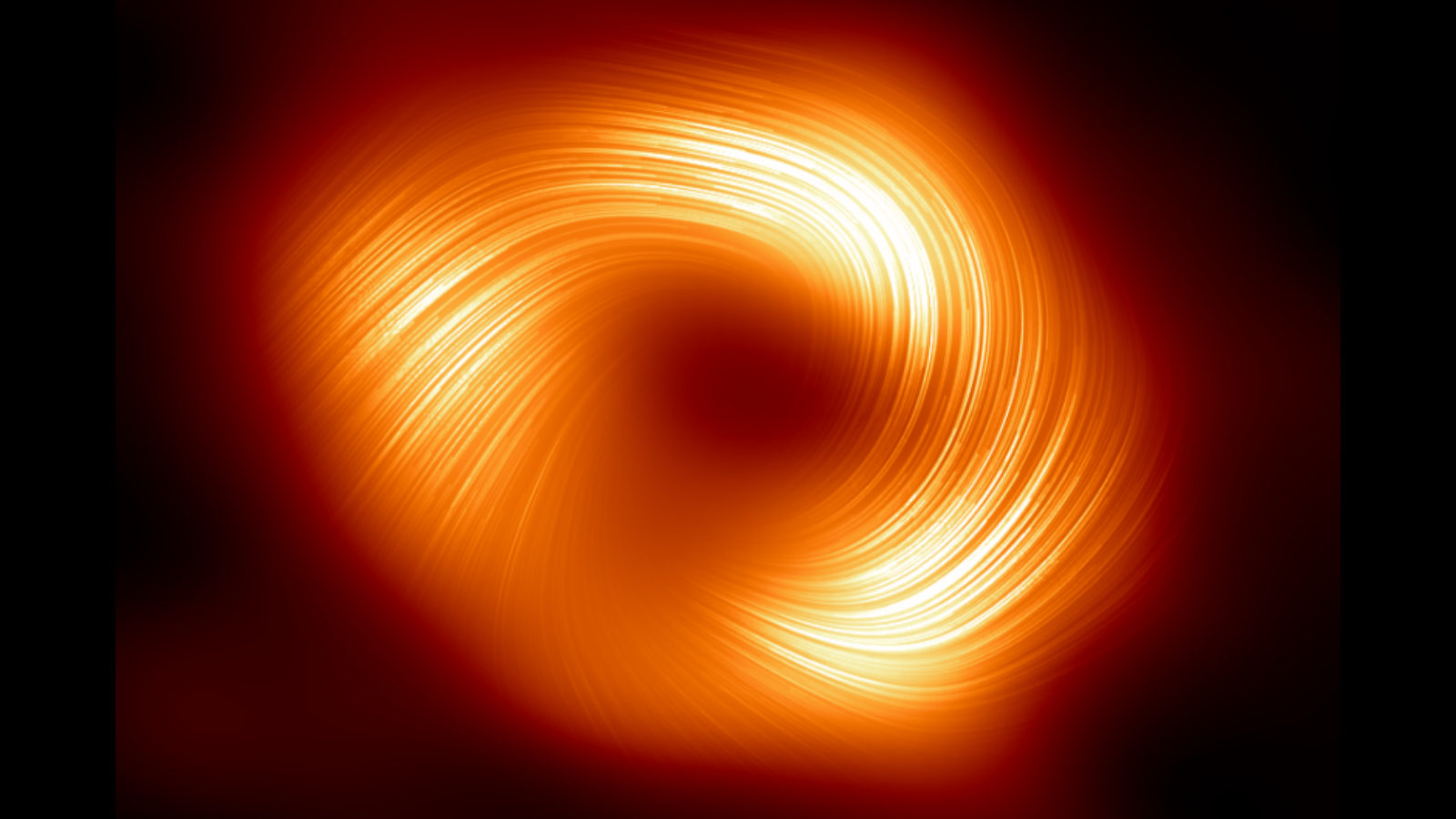Cannibal stars at the heart of the Milky Way stay young in a gruesome way
To remain youthful, the stars bathe in the outer layers of other stars they smash into while being whipped around by the supermassive black hole Sagittarius A*.

Scientists have discovered the gruesome secret behind the apparent youth of some of stars at the heart of the Milky Way — stars participating in a sort of cosmic demolition derby around our galaxy's supermassive black hole, Sagittarius A*, or Sgr A*.
Like a cosmic version of 17th-century serial killer Elizabeth Bathory, who supposedly sought to maintain her youthful glow by bathing in the blood of her victims, some of these stars seem to stay looking young by slamming into their neighbor stars and coating themselves in the stolen stellar material. This cannibalistic process leaves the stellar victim as a strange, stripped "zombie" star as well as dooms the cannibal star to an early death.
This is just a taste of the strange findings that emerged from a simulation of 1,000 densely packed stars that orbit the Milky Way's central supermassive black hole, a study conducted by scientists at Northwestern University.
"Observing the centers of other galaxies is very difficult because they're so far away," Sanaea C. Rose, research lead and a scientist at Northwestern University, told Space.com. "Studying our own Galactic Center can tell us about what goes on in the centers of all galaxies."
The heart of the Milky Way is one of the most extreme environments that astronomers can observe from Earth. This region home to Sgr A*, which is not only a black hole with a mass equivalent to 4.5 million suns, but a cosmic monster that's orbited by over a million stars.
These stars are crammed into an area about 4 light-years wide, roughly the distance between the sun and its closest stellar neighbor, Proxima Centauri. That means events like stellar collisions, which are relatively rare in our sparsely populated region of the Milky Way, are almost commonplace around Sgr A*.
Breaking space news, the latest updates on rocket launches, skywatching events and more!
"The supermassive black hole at the heart of the Milky Way is surrounded by a very dense stellar cluster, and many of these stars whip around in their orbits at speeds between hundreds and thousands of miles per second," Rose said.
Studying the Milky Way's violent heart can thus reveal how stars behave, evolve and interact under the influence of a supermassive black hole's extreme gravity
The part about the cosmic demolition derby
While the team's simulations considered many factors and characteristics, such as stellar mass and star cluster density, one stood out as particularly important when determining the fate of a star near the heart of the Milky Way.
Rose explained that, generally, a star's distance from Sgr A* is a good indication of whether it will collide with another star and what kind of collision that would be.
"The cluster gets more and more densely populated the closer you get to the supermassive black hole, so the likelihood of a collision increases," she said. " “It's a bit like running through an incredibly crowded subway station in New York City during rush hour. If you aren't colliding with other people, then you are passing very closely by them."
The closer a star is to Sgr A*, the faster the immense gravity of the black hole whips it around. As a result, stars right by the supermassive black hole can move at around 18 million miles per hour (29 million kilometers per hour), making the very heart of the Milky Way more akin to a demolition derby than a packed New York subway.
That means that collisions in the innermost region of Sgr A*, referring to an area within about 2,000 times the distance between the Earth and the sun, or 0.01 parsecs, tend to be destructive in nature.
Such stars within about 0.01 parsecs of Sgr A* constantly bump into one another, but this is rarely a head-on collision. That means, like a demolition derby car having its bumper ripped off before driving away, the grazing impacts result in a star shedding its outer layers and then racing along on a collision course alongside another neighbor.
"They whack into each other and keep going. They just graze each other as though they are exchanging a very violent high-five," Rose said.
Just how much material a star undergoing this chaos loses, however, depends on how fast it is moving and how much it overlaps with the star it collides with. One result of these destructive collisions is a strange population of stripped-down stars and stars that look youthful thanks to bathing in hydrogen-rich, ejected stellar matter shed from the former.
Gaining this youthful look comes at a cost, however. The more massive a star is, the quicker it burns through the fuel supply it holds for intrinsic nuclear fusion, a process that prevents it from collapsing under its own gravity. Thus, by piling on this stolen material, these massive stars shorten their own lives.
Further out from Sgr A*, at around 0.1 parsecs, or around 21,000 times the distance between the sun and the Earth, stars collide less often and at more relaxed speeds. When these slower smash-ups occur, Rose and colleagues' simulation showed, a complete merger in which two stars become one huge star is probable.
"Collisions outside 0.01 parsecs are more likely to merge the colliding stars," she added. "Stars within 0.1 parsecs of Sgr A* have a very high chance of experiencing at least one collision over their lifetimes."
Rose explained that one of the most satisfying aspects of using this model to address some of the unexplained observations of stars at the heart of the Milky Way is the fact it's based on a relatively simple calculation.
"Something I found personally very special about my research is it is based on calculating a collision timescale, which is something that is taught relatively early in undergraduate physics education," she said. "It was wonderful to use a relatively simple calculation to learn about an extremely complex environment that is unlike anything we encounter in our solar neighborhood."
The team has produced two studies using the model thus far, one published in The Astrophysical Journal Letters this month and another in September 2023, but they aren't finished with it just yet.
"The next steps are to expand on the physics currently in the model," Rose concluded. "The Galactic Center is an extremely complex environment, so there are always things we can add, and our work is never done!"
Rose presented this research at the American Physical Society's April meeting, held in Sacramento, California, on Thursday (April 4), as part of the session "Particle Astrophysics and the Galactic Center."

Robert Lea is a science journalist in the U.K. whose articles have been published in Physics World, New Scientist, Astronomy Magazine, All About Space, Newsweek and ZME Science. He also writes about science communication for Elsevier and the European Journal of Physics. Rob holds a bachelor of science degree in physics and astronomy from the U.K.’s Open University. Follow him on Twitter @sciencef1rst.

